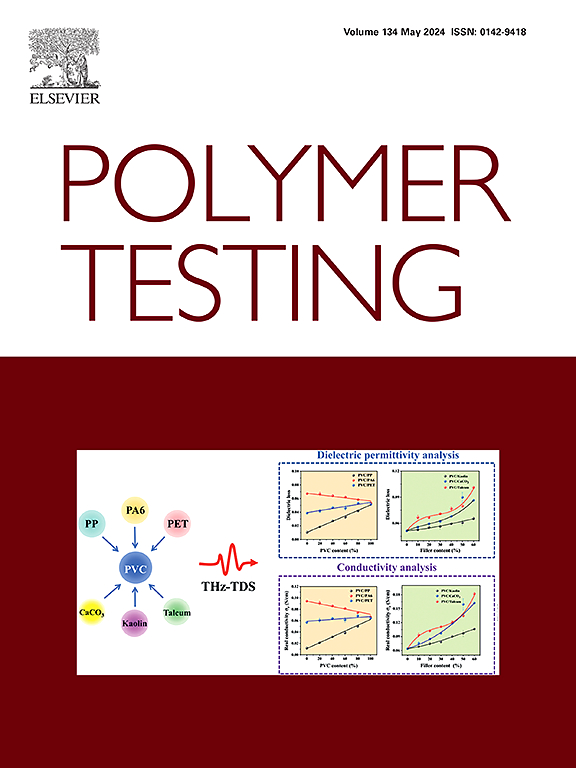基于三周期极小面增材制造短纤维增强复合材料夹层结构的弯曲性能
IF 6
2区 材料科学
Q1 MATERIALS SCIENCE, CHARACTERIZATION & TESTING
引用次数: 0
摘要
三周期极小表面(tpms)由于其优异的力学性能和可扩展性而受到越来越多的关注。设计了Gyroid TPMS芯夹层结构(G-TPMS sandwich),并通过实验、理论和数值方法对其弯曲性能和破坏行为进行了研究。采用碳纤维增强尼龙长丝熔融沉积建模(FDM)法制备了试验样品。建立了理论模型和数值模型,并用实验结果进行了验证。此外,通过参数化研究,研究了几何参数对G-TPMS夹层结构弯曲性能和破坏行为的影响。结果表明:增加G-TPMS芯的相对密度和面板厚度可以提高夹层结构的弯曲模量和峰值载荷;面板厚度为2.5 mm的G-TPMS夹层结构的抗弯模量和峰值荷载分别比面板厚度为1.5 mm的G-TPMS夹层结构高35.46%和36%。相对密度为0.35的G-TPMS夹层结构的抗弯模量和峰值荷载分别比相对密度为0.25的G-TPMS夹层结构高37.5%和41.02%。同时,芯层相对密度较低的G-TPMS夹层结构容易出现剪切破坏模式。所提出的G-TPMS夹层具有应用于航空航天、汽车或海洋工程轻量化结构的潜力。本文章由计算机程序翻译,如有差异,请以英文原文为准。
Bending behavior of additively manufactured short fiber reinforced composite sandwich structures based on triply periodic minimal surface
Triply periodic minimal surfaces (TPMSs) have gained increasing attention because of their excellent mechanical properties and scalability. The Gyroid TPMS core sandwich (G-TPMS sandwich) structure was designed, and its bending performance and failure behavior were studied through experimental, theoretical, and numerical approaches. The test samples were prepared by the fused deposition modeling (FDM) method using the carbon fiber reinforced nylon filament. Theoretical and numerical models were established and verified using experimental results. In addition, the influence of geometrical parameters on the bending performance and failure behavior of the G-TPMS sandwich structures was studied by parametric studies. The results show that the flexural modulus and peak load of the sandwich structures can be enhanced by increasing the relative density of the G-TPMS core and the face sheet thickness. The flexural modulus and the peak load of the G-TPMS sandwich structure with a face sheet thickness of 2.5 mm are 35.46 % and 36 % higher than that of the G-TPMS sandwich structure with a face sheet thickness of 1.5 mm, respectively. The flexural modulus and the peak load of the G-TPMS sandwich structure with a relative density of 0.35 are 37.5 % and 41.02 % higher than that of the G-TPMS sandwich structure with a relative density of 0.25. Meanwhile, the G-TPMS sandwich structures with a lower relative density of the core are prone to shear failure mode. The proposed G-TPMS sandwich has the potential to be applied in lightweight structures for aerospace, automotive, or marine engineering.
求助全文
通过发布文献求助,成功后即可免费获取论文全文。
去求助
来源期刊

Polymer Testing
工程技术-材料科学:表征与测试
CiteScore
10.70
自引率
5.90%
发文量
328
审稿时长
44 days
期刊介绍:
Polymer Testing focuses on the testing, analysis and characterization of polymer materials, including both synthetic and natural or biobased polymers. Novel testing methods and the testing of novel polymeric materials in bulk, solution and dispersion is covered. In addition, we welcome the submission of the testing of polymeric materials for a wide range of applications and industrial products as well as nanoscale characterization.
The scope includes but is not limited to the following main topics:
Novel testing methods and Chemical analysis
• mechanical, thermal, electrical, chemical, imaging, spectroscopy, scattering and rheology
Physical properties and behaviour of novel polymer systems
• nanoscale properties, morphology, transport properties
Degradation and recycling of polymeric materials when combined with novel testing or characterization methods
• degradation, biodegradation, ageing and fire retardancy
Modelling and Simulation work will be only considered when it is linked to new or previously published experimental results.
 求助内容:
求助内容: 应助结果提醒方式:
应助结果提醒方式:


